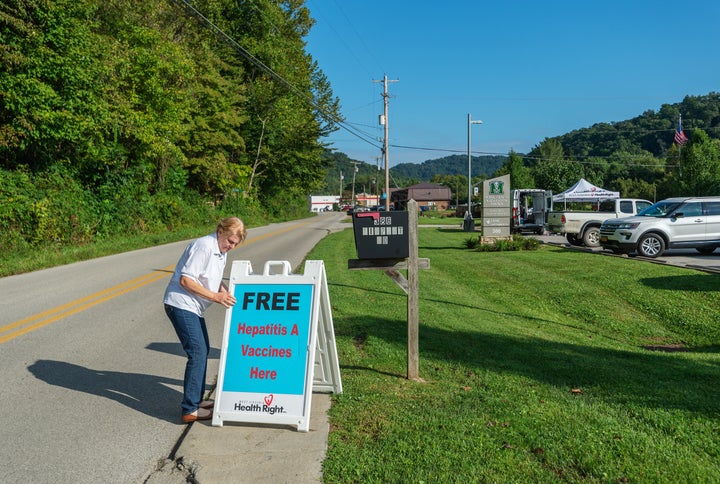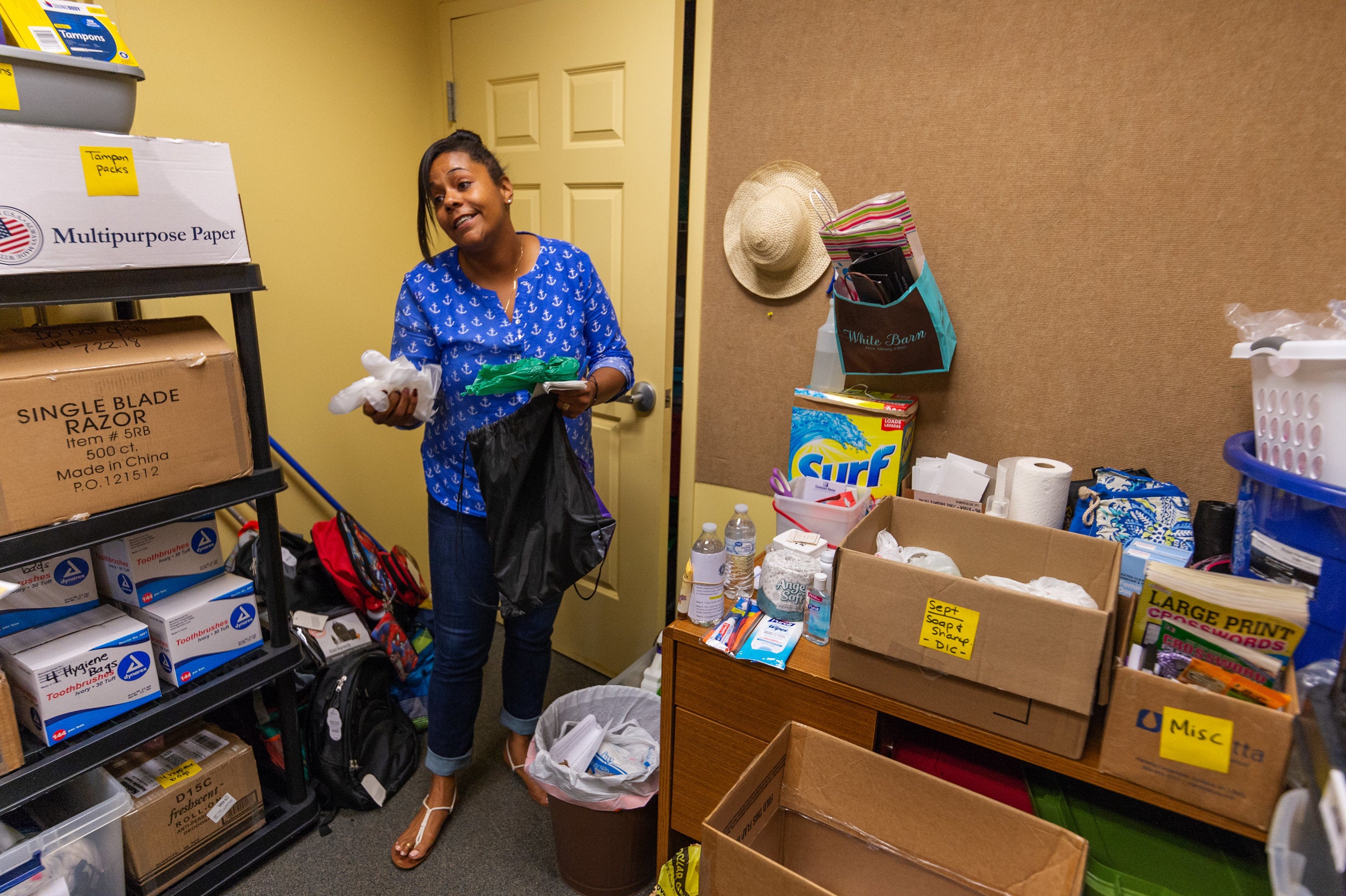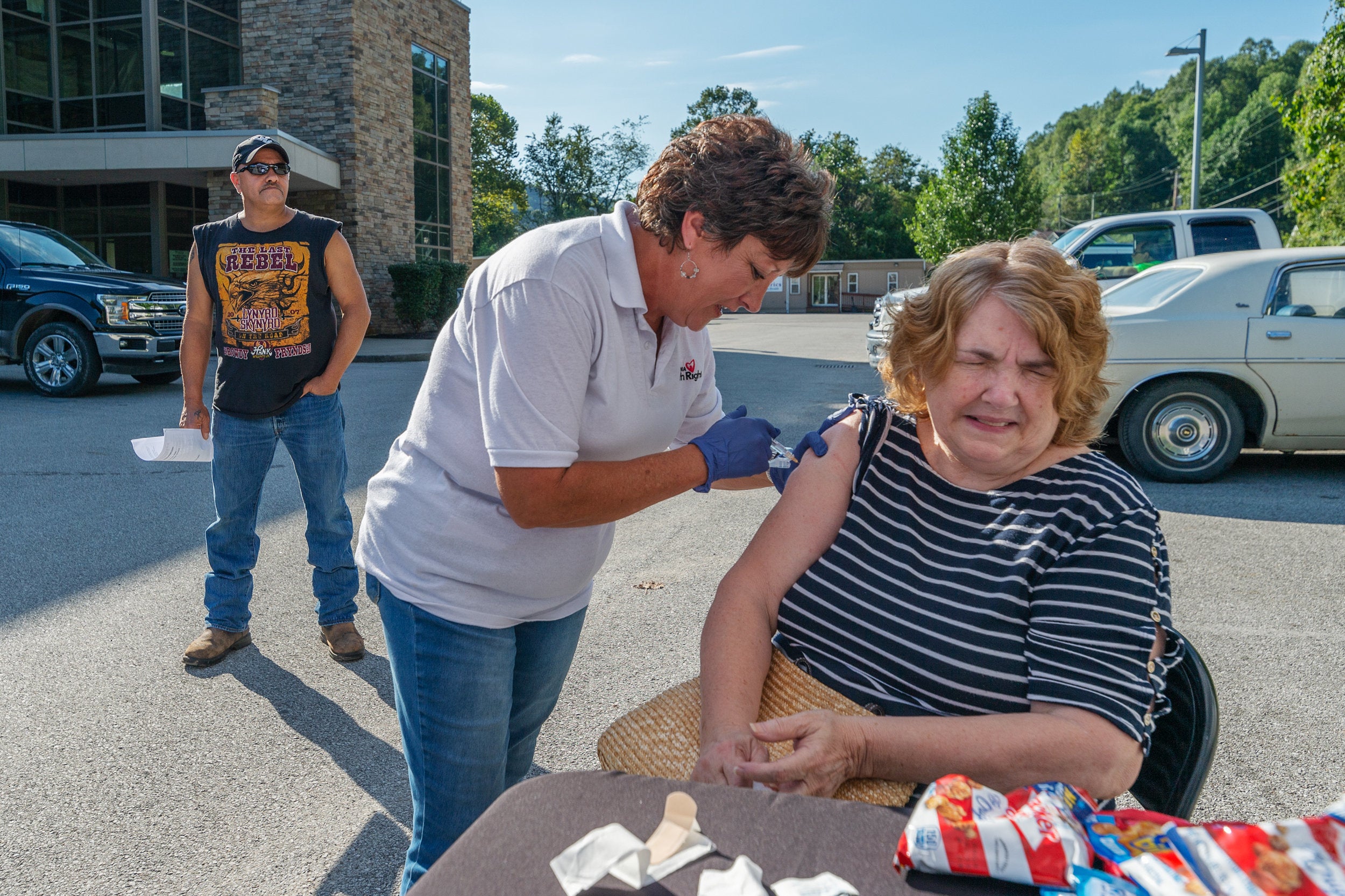
CHARLESTON, W.Va. — Kristi Haynes knew she had a problem when her eyes turned the color of traffic paint.
Haynes had been feeling strangely tired, but she didn’t have many opportunities to look at herself in a mirror because she’d been homeless for a few months. Her fiance noticed her yellow eyes and freaked out. And that’s how Haynes knew she had caught the disease so many of her friends already had: hepatitis A.
Hepatitis A, a vaccine-preventable disease that attacks the liver and is spread by contaminated fecal matter, is a scourge in developing nations with poor sanitation systems. Imported contaminated food is typically to blame when the disease occurs in developed countries.
But U.S. cases of the disease have tripled in 2018, and the outbreak has nothing to do with imported food.
Hepatitis A is spreading among drug-using and homeless populations, with explosions of the disease moving from California to states such as Kentucky, West Virginia, Ohio, Indiana and Missouri.
The toll has been vast: At least 10,582 people have been reported infected so far this year alone, a large number of whom have required extensive — and thus expensive — hospitalizations. Hepatitis A inflicts what feel like severe flu symptoms: nausea, fever, dizziness, overall lethargy and jaundice. Without treatment, severe cases of hepatitis A can cause liver failure. At least 80 people have died from this outbreak.
States, counties and cities have spent millions to fight their local outbreaks, but the money doesn’t address the root causes of the problem: a decaying public health infrastructure, devastated by years of funding cuts, that can’t fully meet the needs of a population driven to homelessness and devastated by the opioid epidemic.
“Unfortunately, I see this hepatitis A outbreak as a symptom of the fraying social safety net,” said Dr. Jeff Duchin, a public health officer for Seattle and King County, Washington.
Craig Hudson for HuffPost
Charleston and surrounding Kanawha County have been a hotbed of West Virginia’s hepatitis A outbreak.
‘A New Normal’
Before 1995, when the hepatitis A vaccine was first licensed in the U.S., about 21,000 Americans were diagnosed with hepatitis A each year, according to the Centers for Disease Control and Prevention. In 2006, the CDC recommended all children be vaccinated, and many states now require that children get the vaccine before attending school.
The release of the vaccine and the spread of immunization caused the number of new cases of the disease to plummet. For the first two decades after the arrival of the vaccine, most outbreaks of hepatitis A in the U.S. were connected to imported contaminated food sources — like the 2016 outbreak due to frozen strawberries or the 2013 outbreak from pomegranate seeds. On a much smaller scale, the U.S. has also previously seen surges in cases among gay, bisexual and other men who have sex with men.
So when San Diego County in California saw a spike in hepatitis A cases starting in late 2016 and there didn’t appear to be an underlying food source, the county was caught by surprise. The county health department discovered the disease was spreading through unsanitary living conditions in tent cities and among drug users who were too old to have been vaccinated before attending school. During the peak of the outbreak that fall, the county sprayed its streets with bleach. The health department launched a massive vaccination campaign, added hand-washing stations and new bathrooms, and handed out human poop bags that people could use to dispose of their waste if they didn’t have regular access to a bathroom.
By the time San Diego quelled the outbreak at the start of 2018, nearly 600 people had been infected and 20 had died. It was just the beginning.
The San Diego strain of hepatitis A began to pop up nationwide at the end of 2017 and the beginning of 2018, in Utah and then in Kentucky, Indiana and West Virginia. Michigan saw an explosion of a different strain of the disease.
Indiana soon took the drastic step of issuing a travel advisory, suggesting that its residents get vaccinated this spring before heading to Louisville for the Kentucky Derby because of the growing outbreak there.
“Disease doesn’t recognize borders when there are outbreaks in neighboring states,” said Pam Pontones, Indiana’s deputy state health commissioner and state epidemiologist.
As it continued to move east, the disease spread primarily through the drug-using population. Unsanitary and sometimes transient conditions associated with drug use put that population at risk for exposure to contaminated fecal matter, health departments say. There is also some evidence to suggest a possible connection between the disease and intravenous drug use, according to Dr. Sapna Bamrah Morris, who helps lead the CDC’s response to hepatitis A.
“These are all the symptoms of the cost and human toll the opioid epidemic is taking,” Rahul Gupta, who was head of the West Virginia Department of Health and Human Resources until November, told HuffPost in September. “It’s much more a telltale sign of the times we’re in and the large epidemic, the tsunami of communicable disease that can happen.”
What made these outbreaks difficult to stop, public health officials say, is that they were hurting the people who are hardest to reach: those who are homeless, transient or using drugs, and who don’t trust the health care system after years of stigmatization.
If these large hepatitis A outbreaks were happening, for example, on college campuses, you’d probably see a different level of energy around getting resources mobilized to respond to them more comprehensively.
Dr. Jeff Duchin, a public health officer for Seattle
Public health departments had to partner with homeless shelters, soup kitchens and needle exchanges to find these cases of hepatitis A. They set up vaccine drives, deployed strike forces of nurses and staff across cities, sent out mobile vaccine units to far away rural areas. That all takes time and money and effort — and the disease is still spreading.
“Reaching the at-risk populations that are currently affected is extremely resource intensive and everyone has limitations on the resources they have,” said Morris from the CDC.
Health departments also have “competing priorities,” she said, like the onslaught of the flu season.
Duchin put it a bit more bluntly.
“If these large hepatitis A outbreaks were happening, for example, on college campuses, you’d probably see a different level of energy around getting resources mobilized to respond to them more comprehensively,” he said.
The entire outbreak demonstrates how public health is failing people most in need of protection, said Jeffrey Howard, the commissioner of Kentucky’s public health department. When the CDC finally issued an advisory to health departments nationwide in June, cases were nearing 2,000 for the year. Now there are closing in on 11,000.
“It is always clear that inequities and disparities in health and health outcomes exist — and they exist across this country,” Howard said. “We have to do a better job of protecting that vulnerable population and I think that’s the responsibility of all of public health.”

Craig Hudson for HuffPost
Brenda Parker, who works for West Virginia Health Right, sets up a sign advertising free hepatitis A vaccines as part of a mobile clinic that travels to rural areas around the state.
Yet all the while, hepatitis A has continued to spread despite health departments’ efforts. And the problem gets worse as those outbreaks move from urban centers to more rural areas that have less public health infrastructure, Howard said. Kentucky and West Virginia have seen such a pattern and have the worst outbreaks to date with 3,265 cases and 2,137 cases, respectively. They’re still seeing new cases every week.
“My guess is we’re going to see a new status quo with hepatitis A,” Howard said. “Hepatitis A is not going to be as rare a disease as it used to be in this country. It’s probably going to be a new normal.”
Decaying Infrastructure
Officials point to declining public health funding to explain the explosion of this preventable disease. More than 56,000 local health department jobs were lost nationwide between 2008 and 2017, according to the National Association of County and City Health Officials (NACCHO). In that time, STD rates have skyrocketed, the opioid crisis now claims more than 115 lives a day, and 80,000 people died of the flu last year.
“As funding cuts happen all along over years, it’s really the public health infrastructure that erodes,” said Lilly Kan, the senior director for infectious disease and informatics at NACCHO. “It continues to be a smoldering issue, but then when you have fires like outbreaks like hepatitis A, then it becomes obvious.”
Nowhere were the consequences of public health cuts more evident than in West Virginia, where Haynes contracted hepatitis A. The state instituted a 24 percent cut in state aid to public health departments in 2016, and several leadership positions remained unfilled as the outbreak spread across the state.
“We’ve been able to manage, and counties that don’t have our resources cannot,” said Dr. Michael Kilkenny, the physician director at the Cabell-Huntington Health Department. “The state is overtaxed and is relying on the CDC.” But the CDC, which has competing priorities and a limited budget, can only do so much.
Kilkenny told WV Public Radio in 2016 that funding cuts “would really cripple” surveillance efforts for all sorts of diseases.
“If we stop watching for those diseases, those diseases will spread, people will get sick and some of those people will die,” he said at the time.

Craig Hudson for HuffPost
Dr. Michael Kilkenny, physician director for the Cabell-Huntington Health Department in West Virginia, has decried cuts to public health funding for years.
West Virginia’s hepatitis A outbreak is now the second-worst in the country. Twelve of the more than 2,000 West Virginians who have been diagnosed with the disease this year have died.
Health departments across the state have lost key staff; the state currently has an interim commissioner of public health. The staffing issues are particularly dire in Kanawha County-Charleston ― the heart of the outbreak, with 782 cases to date. The chief of clinical services at the Kanawha-Charleston Health Department left this year, as did the chief of administration and the chief of health promotion and wellness, according to the former head of the department. Five administrative assistants were let go due to budget cuts in 2017.
Dr. Michael Brumage, the former department head, departed this year amid public backlash over a controversial needle exchange in Charleston that shut down in February. And Brenda Isaac, the president of the county’s health board, resigned in October, saying she had become a “lightning rod” in the mayoral race, which was largely a referendum on the needle exchange. The interim head of the city’s public health department is working part-time.
“It was a really unfortunate set of circumstances that depleted the health department of resources right when they needed it most,” said Brumage, who is now the assistant dean for public health practice and service at the West Virginia University School of Public Health. “Even under the best of circumstances it’s difficult to recruit personnel as funding has been slashed over the years.”

Craig Hudson for HuffPost
Dr. Angie Settle leads West Virginia Health Right, which has been instrumental in fighting hepatitis A on the ground in Charleston.
The Kanawha-Charleston Health Department didn’t move fast enough to combat hepatitis because it was distracted by the fight over the needle exchange, said Dr. Angie Settle, the CEO and executive director of West Virginia Health Right, a free health care clinic in Charleston. The county didn’t ramp up its efforts until new cases were peaking in the summer, added Ellen Allen, the executive director of Covenant House, a day shelter in downtown Charleston. Both organizations have played important roles in fighting the outbreak.
“We requested the health department to come in February, but we felt like we kept it too limited in scope,” Allen said. “We should have gotten our arms around this in the spring.”
Human Poop Bags
The primary populations affected by the outbreak — homeless people and drug users — are served by Covenant House, which has seen a sharp uptick in people coming through the door as the West Virginia economy has struggled in recent years.
Briana Martin, who manages the needs of people who drop in each day at Covenant House, knows at least 10 people in the day shelter who have been infected. She makes sure to wash her hands after interacting with people who have been exposed to hepatitis A. For those who haven’t been vaccinated against the disease, all it would take to contract hepatitis A would be to shake hands with someone who has it or touch the bathroom door before eating.
The health department has been handing out bags filled with wipes, a toothbrush, toothpaste, two water bottles, toilet paper, hand sanitizer, gloves, detailed sanitary instructions — and a poop bag. Over 85 people at Covenant House had received the kits as of September.

Craig Hudson for HuffPost
Briana Martin, drop-in center manager at Covenant House, shows the bags of hygienic products that are handed out to at-risk populations in Charleston. The green bag is for people to use to clean up their own waste.
But sanitary problems persist. Allen said her staff often cleans up poop outside the shelter. She has requested more outdoor bathrooms, but nothing has changed — and the shelter is only open 8 a.m. to 4 p.m.
It’s just another sign that things continue to worsen for those without a safety net, according to Allen.
“I’ve never seen anything like this,” she said. “I’ve been in nonprofit work for 11 years now and just the last year the acceleration and the decrease in the well-being of people — it’s heartbreaking.”
Almost all of the 20 or so people at Covenant House one afternoon this September said they had heard of hepatitis A. Yellow signs with bold letters urging people to get vaccinated dotted the walls.
Haynes, who asked not to be photographed, was there doing her laundry. A middle-aged man who was visiting the shelter and did not want to be identified said he had a friend who had died after contracting hepatitis A, which complicated his underlying hepatitis B and C.
Terrell, a Covenant House visitor who declined to give his last name, sat outside the doors for a few hours before making his way in to tease the staff. But when asked about hepatitis A, he answered quickly. “I’ve seen people about to die of it — wait till they’re about to die before they go in,” he said. “Isn’t it a third-world disease and some shit?”

Craig Hudson for HuffPost
Terrell, who is currently homeless, said he has seen the effects of hepatitis A up close.
The Damage Done
The financial costs of these outbreaks have been high, and they’re still rising.
San Diego County estimates it spent $12.5 million to quell its outbreak, which is one-quarter the size of West Virginia’s. Kentucky has allocated $2 million so far to the vaccine alone, which doesn’t even count federal money. The underlying hospitalization costs are astronomical, which Brumage said ends up affecting both hospitals and taxpayers because so many members of the at-risk populations are uninsured.
“Those are very extensive hospitalizations that itself would be several million,” said Gupta, West Virginia’s former public health commissioner.
This doesn’t even begin to account for the other resources, such as time, that public health departments and community partnerships have put toward battling the outbreaks.

Craig Hudson for HuffPost
West Virginia Health Right sponsors mobile clinics that deliver hepatitis A vaccinations and HIV testing to rural areas across the state.
And news of an outbreak can devastate a local economy.
Popular fast food restaurants in West Virginia have taken a massive hit, said Tri-State Restaurant Association spokesman Mike Kirtner. The organization was formed after Ohio, Kentucky and West Virginia saw hepatitis A cases take off. Hepatitis A cases have shut down several restaurants in the Charleston area this year, and Kirtner said one major chain lost 70 percent of its business in a single day after a case of hepatitis A was reported. Waitresses at affected restaurants have seen their tips decrease, Kirtner said, sometimes from as much as $300 a day to just $50.
Blame Game
Politicians, local TV news and the public have blamed just about everything except the lack of public health funding for the outbreak in West Virginia.
“It all came from restaurants,” Danny Jones, Charleston’s outgoing mayor, told HuffPost.
But none of the West Virginia cases have been traced to food contamination. However, Kirtner said, restaurant workers, who are at much higher risk for the disease, are disproportionately represented among intravenous drug users.
Jones also criticized the health department for the outbreak, saying it “caught it a little late.” But the real problem, he argued, was a “needle mill” that attracted undesirable people to Charleston.
“Too many free meals drawing people in,” he said.
Rhetoric like that — the idea that services helping the homeless and drug-using people are destroying Charleston — is becoming more mainstream.
A private Facebook group called “Charleston Has Had Enough” blames “junkies, bums, thieves, dangerous people, most from out of state,” for the area’s growing problems and encourages users to “post your photos of troublemakers.”

Facebook
The group has more than 4,600 members, which is comparable to about 10 percent of the city’s population. Users post unflattering photos of people who appear to be among the area’s homeless and drug users, and some include racist and homophobic captions.
“I’m moving, but in the meantime, I want to feel safe and I want these nasty creatures to leave my car, porch, home and business alone!” one group member wrote recently.
Next Year’s Cases
That sort of dehumanization of the people most at risk for hepatitis A will make it difficult for public health providers to fight the disease. But there are a few bright spots, said Morris of the CDC.
She is heartened by the sharing of information among afflicted states, the raised awareness about the issue among health departments nationwide, and the new recommendations from the CDC’s vaccination advisory panel to make hepatitis A vaccination routine for the homeless — a public health first.
But Morris said she’s not sure what next year’s case count could look like.
“I am hopeful we may not see the larger outbreaks that we’re seeing currently, but it is very difficult to predict,” she said.
Other public health experts are more pessimistic.
“There is a good reason to suspect that this will further spread to other states,” Gupta warned. “This is not yet over.”
For Howard in Kentucky, just one question remains: “This is a disease of developing countries. One has to ask: Why are we seeing it in the U.S.?”
Be the first to comment